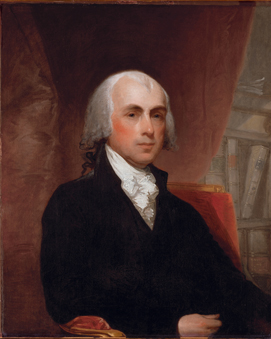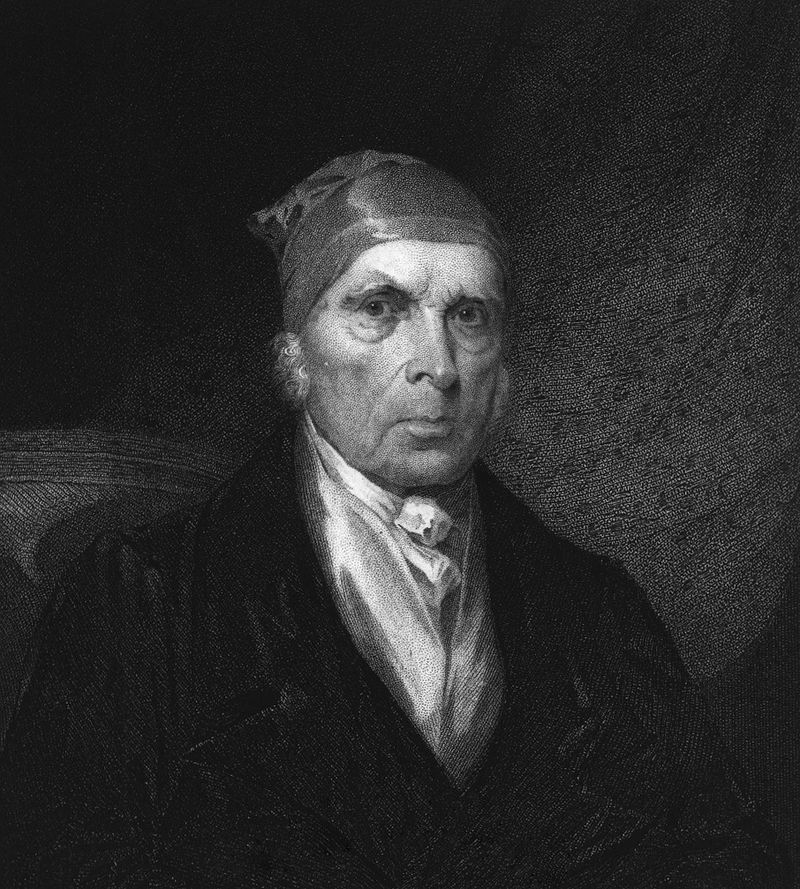James Madison Jr. was the fourth President of the U.S., serving from 1809-1817. Not only that, he wrote the first draft of the constitution, drafted the bill of rights, was secretary of state, and co-founded the democratic-republican party with Thomas Jefferson. Madison was the president who led the U.S. into war with Great Britain for the second time.
Born on March 16, 1751 in Port Conway, Virginia to James Madison Sr. and Nellie Conway Madison, he was the eldest of twelve children. Madison’s father was a tobacco planter in Orange County, Virginia. He later inherited his father’s land and became the largest landowner in Orange County by expanding it and adding more slaves. At eighteen, Madison left Virginia to attend the College of New Jersey, or Princeton as it is now known.
When the American Revolution was about to begin, Madison became a colonel in the Orange County Militia. Madison was often sick, so he resigned and decided to take up politics. At the Virginia Constitutional Convention in 1776, a year after the war had begun, Madison was the one to represent Orange County. There, Madison and Thomas Jefferson met for the first time. The two would later become lifetime friends.
Madison was known to fight for religious freedom. He became a Virginia delegate to the Continental Congress in 1780. Three years later he returned to Virginia and created a religious freedom statue. Not long after, Madison returned to congress when the constitution was being created.
After lots of studying, Madison decided that America needed a much stronger government after the Articles of Confederation had been passed. He had strong beliefs that no branch should have more power than others. Not only that, but he also suggested the idea of enhancing the roles of governors and judges to help state legislatures.
In May 1787, Madison represented Virginia at the Constitutional Convention. He presented his ideas at the convention for the U.S. government to have three branches. These three branches, the legislative, judicial, and executive are still standing today because of Madison. Often times Madison was called “father of the constitution” because of his contributions towards it.
After the constitution had been written but not yet ratified by at least nine of the colonies, Madison wrote essays promoting it. These were later called the Federalist Papers. Alexander Hamilton and John Jay wrote essays contributing to the Federalist Papers as well.
In 1788, the constitution had finally been ratified by the states and was passed. Madison was quickly elected to join the House of Representatives. He served for eight years from 1789-1797. Madison was also working with congress at that time drafting the Bill of Rights. The bill of Rights was later ratified and passed in 1791.
Madison and Jefferson founded the democratic-republican party in 1792. This was because they often found themselves disagreeing with the federalists ideas. Madison, Jefferson, and James Monroe later became the only three democratic-republicans to serve as president.
In 1794, Madison, who was forty-three at the time, married twenty-six year old Dolley Payne Todd. Dolley was a widow with a young son. She was notably very outgoing as well. Not only that, but she also hosted many parties and dinners which helped Madison to meet more political figures. It is noted that the two were hardly apart during their marriage. It lasted forty-one years when Madison died in 1836. Dolley would later die thirteen years later in 1849.
Madison was appointed Secretary of State when Jefferson was elected president. He served in this role from 1801 to 1809. He was known to have helped Jefferson in taking ownership of Louisiana. Him and Jefferson placed a ban on all incoming ships and trade with France and Britain in 1807. This was because the countries were angry the U.S. was not helping them in war and had begun to attack their ships. Jefferson ended the ban in 1809 before leaving office because it turned out to be hurting America more than Europe.
In 1808, Madison beat his Federalist candidate, Charles Cotesworth Pinckney, and was elected president. Britain was still attacking U.S. ships and had begun recruiting U.S. sailors for its navy. Madison was facing troubles stopping these events from happening.
Despite America being unprepared for war, Madison declared war against Britain in 1812. Many states would not allow their militias fight and congress hadn’t been able to provide any funds to the army. The U.S. was defeated greatly. However, because of their well built ships they were somewhat successful in that department.
Madison beat Federalist DeWitt Clinton in the next election. Trade had stopped between America and the UK yet again, only hurting America more. When British troops had begun to burn Washington D.C. in 1814, Madison fled the White House and Washington D.C.
In December of 1814, the Treaty of Ghent was signed and the war ended. Word of the war ending had not yet spread throughout the whole country though when the Battle of New Orleans took place. American Soldiers defeated the British, a major victory for the losing Americans. Though he was once viewed poorly for starting the war, Madison was eventually celebrated after America’s victories.
Madison returned to Montpelier, Virginia once his term expired in 1817. Thomas Jefferson had founded the University of Virginia and made Madison rector in 1826. He died at eight-five years old in Montpelier on June 28, 1836.




